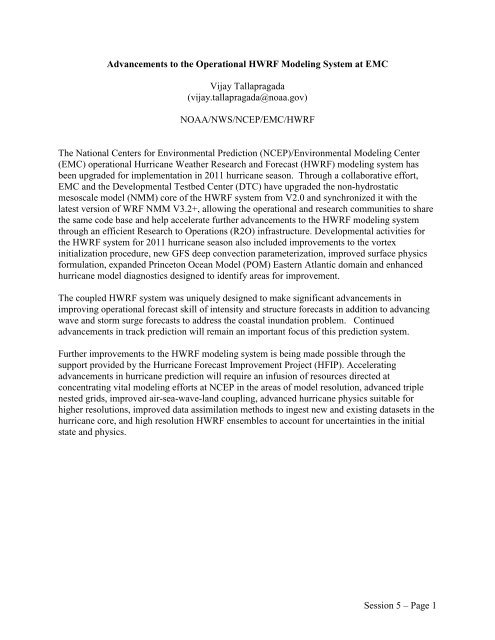65th IHC Booklet/Program (pdf - 4.9MB) - Office of the Federal ...
65th IHC Booklet/Program (pdf - 4.9MB) - Office of the Federal ...
65th IHC Booklet/Program (pdf - 4.9MB) - Office of the Federal ...
Create successful ePaper yourself
Turn your PDF publications into a flip-book with our unique Google optimized e-Paper software.
Advancements to <strong>the</strong> Operational HWRF Modeling System at EMC<br />
Vijay Tallapragada<br />
(vijay.tallapragada@noaa.gov)<br />
NOAA/NWS/NCEP/EMC/HWRF<br />
The National Centers for Environmental Prediction (NCEP)/Environmental Modeling Center<br />
(EMC) operational Hurricane Wea<strong>the</strong>r Research and Forecast (HWRF) modeling system has<br />
been upgraded for implementation in 2011 hurricane season. Through a collaborative effort,<br />
EMC and <strong>the</strong> Developmental Testbed Center (DTC) have upgraded <strong>the</strong> non-hydrostatic<br />
mesoscale model (NMM) core <strong>of</strong> <strong>the</strong> HWRF system from V2.0 and synchronized it with <strong>the</strong><br />
latest version <strong>of</strong> WRF NMM V3.2+, allowing <strong>the</strong> operational and research communities to share<br />
<strong>the</strong> same code base and help accelerate fur<strong>the</strong>r advancements to <strong>the</strong> HWRF modeling system<br />
through an efficient Research to Operations (R2O) infrastructure. Developmental activities for<br />
<strong>the</strong> HWRF system for 2011 hurricane season also included improvements to <strong>the</strong> vortex<br />
initialization procedure, new GFS deep convection parameterization, improved surface physics<br />
formulation, expanded Princeton Ocean Model (POM) Eastern Atlantic domain and enhanced<br />
hurricane model diagnostics designed to identify areas for improvement.<br />
The coupled HWRF system was uniquely designed to make significant advancements in<br />
improving operational forecast skill <strong>of</strong> intensity and structure forecasts in addition to advancing<br />
wave and storm surge forecasts to address <strong>the</strong> coastal inundation problem. Continued<br />
advancements in track prediction will remain an important focus <strong>of</strong> this prediction system.<br />
Fur<strong>the</strong>r improvements to <strong>the</strong> HWRF modeling system is being made possible through <strong>the</strong><br />
support provided by <strong>the</strong> Hurricane Forecast Improvement Project (HFIP). Accelerating<br />
advancements in hurricane prediction will require an infusion <strong>of</strong> resources directed at<br />
concentrating vital modeling efforts at NCEP in <strong>the</strong> areas <strong>of</strong> model resolution, advanced triple<br />
nested grids, improved air-sea-wave-land coupling, advanced hurricane physics suitable for<br />
higher resolutions, improved data assimilation methods to ingest new and existing datasets in <strong>the</strong><br />
hurricane core, and high resolution HWRF ensembles to account for uncertainties in <strong>the</strong> initial<br />
state and physics.<br />
Session 5 – Page 1
















